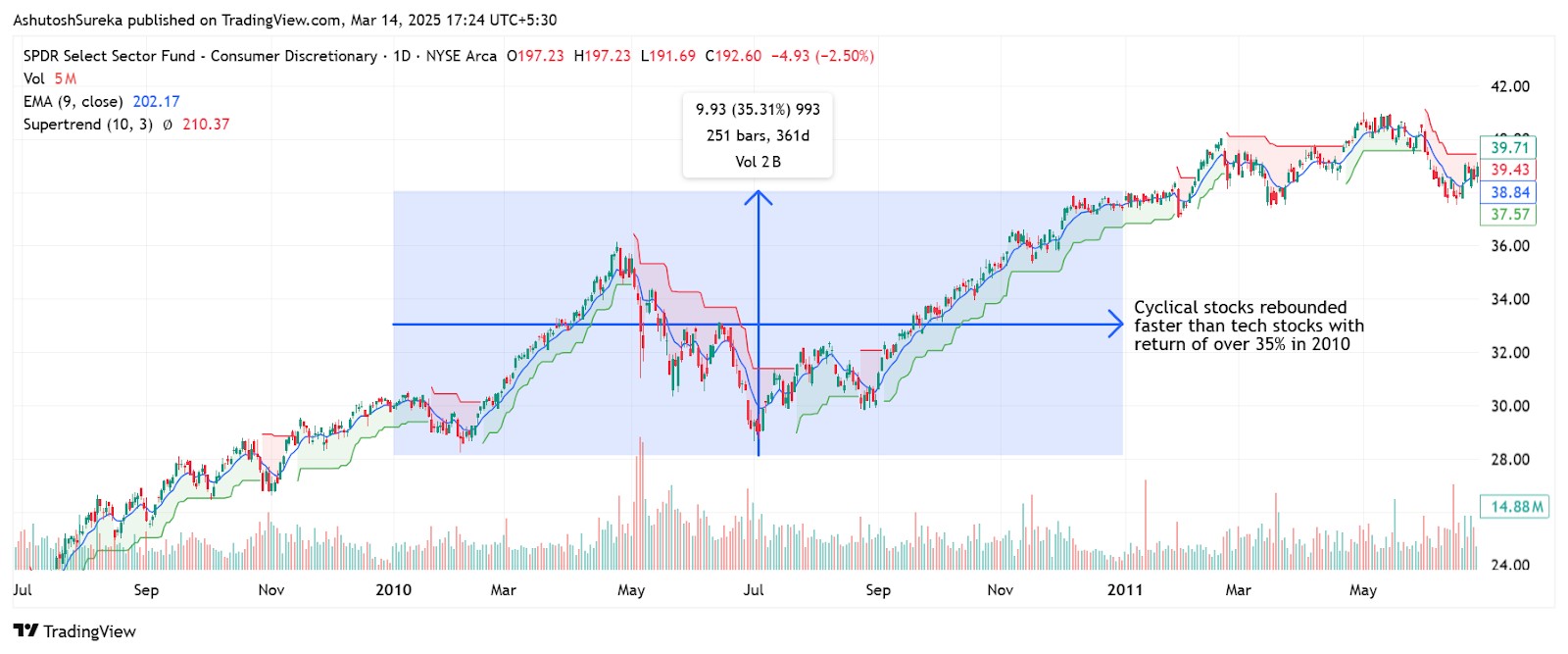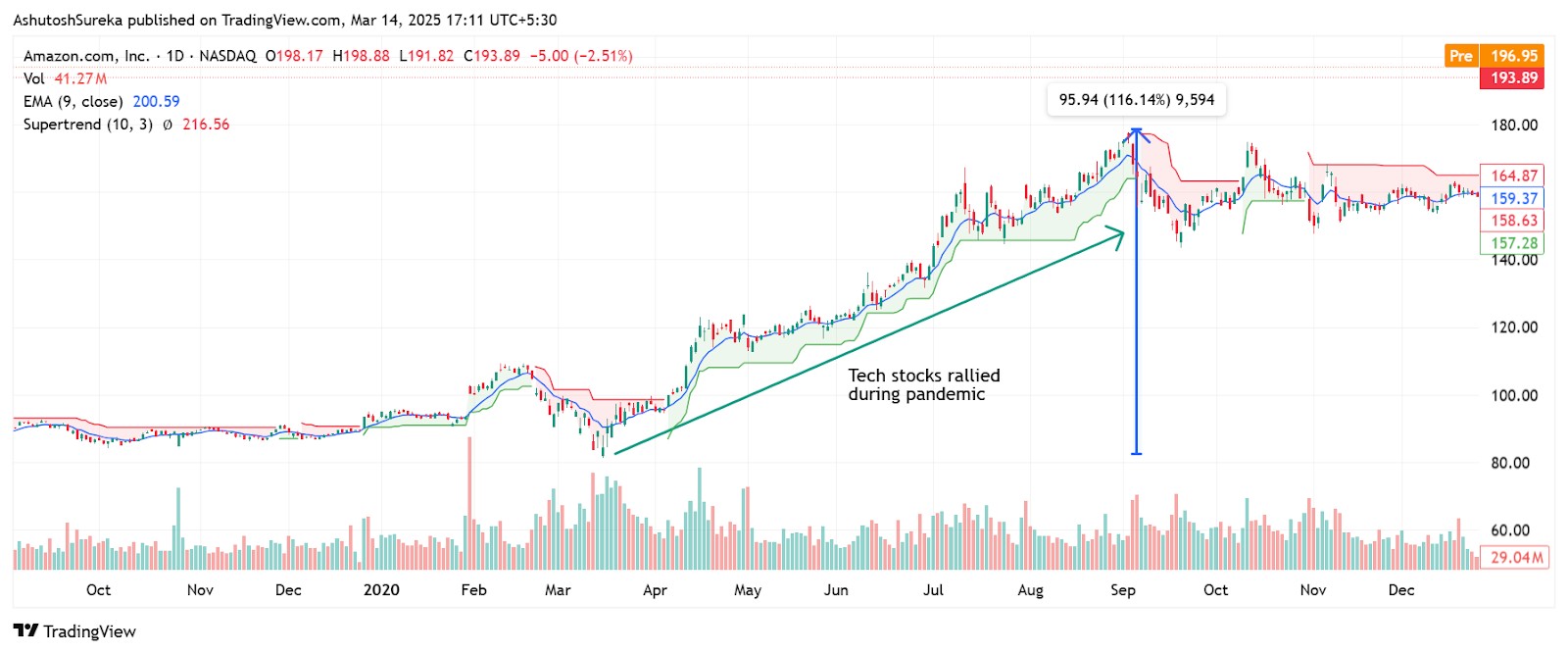Tech vs. Cyclical Stocks. Navigating Sector Rotations For Smarter Investing



Editorial Note: While we adhere to strict Editorial Integrity, this post may contain references to products from our partners. Here's an explanation for How We Make Money. None of the data and information on this webpage constitutes investment advice according to our Disclaimer.
Sector rotation is the movement of investor money between industries based on economic cycles. Tech stocks thrive during economic booms, while cyclical stocks — such as financials, energy, and industrials — perform well during recoveries. However, not all tech stocks fall when cyclicals rise, and not every cyclical stock benefits from growth periods.
Many investors assume that tech and cyclical stocks move in opposite directions — when one rises, the other must fall. However, market rotations don’t follow a fixed pattern. The real challenge isn’t just identifying when these shifts occur, but understanding why they happen and which stocks actually benefit. Tech stocks can sometimes remain strong even when cyclical stocks rally, and not all cyclical stocks perform well during economic booms.
The best opportunities arise when tech stocks are undervalued due to interest rate fears or when cyclical stocks become overbought due to excessive optimism. Investors who can spot these mispricings early can position themselves ahead of the market, rather than reacting too late and chasing trends that have already played out.
This article explores how sector rotations impact tech and cyclical stocks, why they don’t always move in opposite directions, and how investors can spot mispriced opportunities.
Risk warning: All investments carry risk, including potential capital loss. Economic fluctuations and market changes affect returns, and 40-50% of investors underperform benchmarks. Diversification helps but does not eliminate risks. Invest wisely and consult professional financial advisors.
Understanding sector rotation
Sector rotation is a key strategy in investing, where investors shift their focus from one sector to another based on economic conditions. This movement often involves a rotation between technology stocks and cyclical industries, as different sectors perform better during different phases of the economic cycle. Understanding how sector rotation works can help investors adjust their portfolios to maximize returns and manage risk.

Definition of sector rotation
Sector rotation happens when investors move their money between different industries based on where the economy is headed. Some industries do well when the economy is strong, while others hold up better during slowdowns.
How does sector rotation work?
In good economic times, investors favor tech stocks and growth companies because businesses and consumers spend more.
During economic slowdowns, they shift to defensive industries like healthcare and consumer staples, which remain steady.
As the economy rebounds, industries like banks, energy, and industrial companies tend to grow as businesses and consumers start spending again.
Why does this matter?
Helps boost returns by focusing on sectors that are performing well.
Reduces risk by moving money away from struggling industries.
Keeps investments aligned with economic conditions instead of sticking to one approach.
Role of economic cycles

The economy doesn’t move in a straight line — it goes through periods of growth, slowdowns, and recoveries. Different industries perform better depending on where we are in this cycle.
The four main economic phases and sector performance
Economic Growth (Boom periods)
- Best-performing sectors. Technology, retail, and financials.
- Why? Businesses and consumers spend more, increasing demand for new gadgets, financial services, and travel. Stock prices in these sectors often rise due to higher earnings and expansion.
Slowing Growth (Near the peak)
- Best-performing sectors. Energy, construction, and real estate.
- Why? Interest rates may rise, but demand for infrastructure, housing, and industrial projects remains steady. Investors often shift focus to sectors with strong cash flow and pricing power.
Recession (Economic decline)
- Best-performing sectors. Healthcare, utilities, and consumer staples.
- Why? When economic conditions weaken, investors move money into defensive sectors — industries that people rely on regardless of market conditions, such as healthcare, electricity, and basic consumer goods.
Recovery (Getting back on track)
- Best-performing sectors. Banks, manufacturing, and retail.
- Why? As businesses start hiring and consumer confidence returns, industries linked to economic activity, such as banking and manufacturing, rebound. Retail also sees renewed spending as job stability improves. Discover which sectors lead after a recession and how to spot them early.
Why does this matter for investors?
Some industries do better in different economic conditions — knowing this helps investors make smarter moves.
Adjusting your portfolio as the economy shifts can help increase returns and avoid losses.
Characteristics of technology and cyclical sectors
When investing, people often compare technology stocks and cyclical stocks to see which performs better in different economic conditions. Tech stocks focus on innovation and long-term growth, while cyclical stocks depend more on consumer demand and business activity.
Technology sector
The technology sector includes companies that make software, AI, cloud computing, and consumer electronics. These businesses grow fast and drive major changes in industries, but they can also be volatile and sensitive to economic shifts.
What makes tech stocks different?
Big potential for growth
- Tech companies invest a lot in research and development (R&D) to stay ahead of competitors.
- New trends like AI and cybersecurity create constant opportunities for expansion.
A few big companies lead the market
Stock prices can be unpredictable
- Tech stocks rise and fall quickly, especially when earnings reports or economic news come out.
- High valuations mean that even small changes in investor expectations can cause big price swings.
Interest rates affect tech stocks
- When interest rates go up, tech stocks tend to struggle because borrowing money gets more expensive.
- When rates go down, investors often buy tech stocks for their growth potential.
How to invest in tech?
Stick with companies that have strong earnings and a history of innovation.
Pay attention to interest rates, as tech stocks often perform better when rates are low.
Diversify across tech industries like cloud computing, AI, and semiconductors.
Cyclical sectors
Cyclical stocks are tied to economic trends. When people and businesses spend more, these industries boom. But when spending slows down, they struggle. This group includes energy, financials, travel, and manufacturing.
What makes cyclical stocks unique?
They follow the economy
- When people buy cars, travel, or renovate homes, cyclical industries benefit.
- During downturns, spending shrinks, hurting profits for these companies.
They do best in economic booms
- Banks and financial firms make more money when businesses borrow and invest.
- The travel, retail, and auto industries thrive when consumers have extra cash.
They slow down during recessions
- When the economy contracts, companies in these industries see falling profits and job cuts.
- Investors move their money into safer stocks, like healthcare and utilities.
Many cyclical stocks pay dividends
- Unlike most tech stocks, many cyclical companies pay high dividends when business is strong.
- This can provide steady income even when stock prices drop.
How to invest in cyclical stocks?
Buy during economic recoveries when demand is rising.
Keep an eye on inflation and interest rates, as they impact industries like energy and banking.
Look for companies with strong balance sheets that can survive downturns.
We have carefully selected a list of brokers that offer access to stocks aligned with different economic cycles. These brokers provide the tools and resources needed to invest strategically in sectors that thrive during each phase of the market.
| Stocks | Foundation year | Account min. | Demo | Research and data | Basic stock/ETF fee | Deposit Fee | Withdrawal fee | Regulation | TU overall score | Open an account | |
|---|---|---|---|---|---|---|---|---|---|---|---|
| Yes | 2007 | No | Yes | Yes | $3 per trade | No | $25 for wire transfers out | FINRA, SIPC | 7.63 | Open an account Via eOption's secure website. |
|
| Yes | 2014 | No | No | Yes | Zero Fees | No | No charge | FCA, FSCS, OSC, BCSC, ASC, MSC, IIROC, CIPF. | 7.39 | Open an account Via Wealthsimple's secure website. |
|
| Yes | 1919 | No | No | Yes | Zero Fees | No | $25 | FDIC, FINRA, SIPC, SEC, CFTC, NFA | 6.61 | Study review | |
| Yes | 2015 | No | No | Yes | Standard, Plus, Premium, and Metal Plans: 0.25% of the order amount. Ultra Plan: 0.12% of the order amount. | No | No charge up to a limit | FCA, SEC, FINRA | 7.69 | Study review | |
| Yes | 1978 | No | Yes | Yes | 0-0,0035% | No | No | FCA, ASIC, MAS, CFTC, NFA, CIRO | 7.45 | Open an account Your capital is at risk. |
Historical patterns of sector rotation
Investors have always shifted money between technology stocks and cyclical industries based on how the economy is performing. Looking at past trends can help investors recognize patterns and prepare for future changes in the market.
Looking at specific market shifts helps explain how sector rotation happens in real-time.
1. Tech crash and energy surge (2000-2003)
In the late 1990s, investors poured money into tech stocks, driving them to extreme highs.
After the 2000 crash, investors moved into energy and industrial stocks, which benefited from rising oil prices.
2. Post-financial crisis shifts to cyclical stocks (2009-2011)
The 2008 crisis devastated financial and real estate stocks, while tech held up better.
As the economy recovered (2009-2011), cyclical stocks rebounded faster than tech.


3. COVID-19 shift to tech, then back to cyclical (2020-2022)
In 2020, lockdowns boosted tech stocks, but by 2022, travel and retail stocks were back in favor.

4. AI-fueled tech boom (2023-present)
Interest rates hurt tech in 2022, but in 2023, AI and semiconductor companies surged, leading to another tech rally.
Strategies for investors during sector rotations
As economic conditions change, different industries take turns leading the stock market. Investors who understand how to adjust their portfolios during these shifts can reduce risk and capitalize on emerging opportunities. Three key strategies include diversification, smart timing, and using sector ETFs.
Diversification
No single industry consistently outperforms others. Having a mix of investments across sectors ensures that losses in one area can be balanced by gains in another.
How diversification helps investors:
Prevents heavy losses when a sector declines
- If technology stocks drop, sectors like energy or consumer staples may perform better and soften the impact.
- In 2022, tech stocks struggled while energy companies surged due to higher oil prices.
Provides exposure to different industries
- Some years favor high-growth sectors like technology and healthcare. Other years, financials, industrials, and consumer discretionary stocks take the lead.
Avoids relying too much on one sector
- Predicting which industry will perform best is difficult. Diversification ensures steady participation in multiple opportunities.
How to diversify effectively:
Balance investments between growth sectors such as technology and stable sectors like utilities and healthcare.
Use sector ETFs to spread exposure across multiple companies in a given industry.
Timing the market
Some investors attempt to jump in and out of sectors based on economic trends. While this can sometimes work, it is extremely difficult to execute consistently.
Challenges of timing the market:
The economy does not always follow a predictable pattern
- Even when conditions suggest that a particular sector should perform well, surprises can happen.
- In 2023, rising interest rates were expected to hurt technology stocks. However, AI-driven demand caused many tech companies to rally instead.
Many investors buy too late
- When a sector becomes popular, much of its growth potential has already been realized. Buying late often leads to lower returns or losses.
Market sentiment is unpredictable
- News events, policy changes, and global factors can trigger sector rotations unexpectedly.
A better approach than market timing:
Keep an eye on economic indicators such as interest rates, inflation, and GDP growth. These factors influence sector performance over time.
Adjust investments gradually instead of making sudden, drastic moves.
Focus on long-term trends rather than short-term speculation.
Using sector ETFs
Sector ETFs provide exposure to entire industries, making it easier to shift investments without selecting individual stocks.
Why sector ETFs are useful
Instant diversification within a sector
- Rather than investing in one company, sector ETFs allow participation in a broad range of industry leaders.
- The Technology Select Sector ETF includes major firms like Apple, Microsoft, and Nvidia, providing comprehensive exposure to tech.
Reduces risk compared to stock-picking
- If one company underperforms, the ETF still holds other strong players in the same industry.
- This helps balance out the impact of poor earnings or negative news affecting a single company.
Makes shifting between sectors easier
- Investors can adjust their sector exposure without buying and selling multiple stocks individually.
- When rotating from technology to energy, an investor could move from a tech-focused ETF to an energy-focused ETF instead of trading several stocks.
How to use ETFs wisely
Adjust ETF holdings based on changes in market conditions and economic cycles.
Use ETFs as a tool for increasing or reducing exposure to specific industries without having to manage individual stocks.
Avoid extremes and spotting mispricing
A common misstep among investors is thinking they have to jump entirely from tech to cyclical when the market shifts. But the best investors don’t make extreme moves — they focus on specific stocks that still have room to run. Some tech companies, especially those with strong cash flow, can perform well even in rising rate environments, while certain cyclical stocks may have already surged too far before an economic recovery has even taken hold. Instead of trying to predict every twist and turn, it’s more useful to find areas where the market’s assumptions seem off.
Another factor many overlook is the role of corporate debt. When credit markets tighten, it’s often an early warning sign that investors are getting worried about economic growth. This isn’t just important for cyclicals — it also affects tech, particularly companies that rely on borrowing to fund expansion. On the other hand, when credit markets loosen, sectors like construction and manufacturing tend to move first. Most investors focus only on interest rates, but tracking the corporate bond market can offer clues about where the next shift might happen. Understanding these signs helps investors stay ahead instead of reacting too late.
Conclusion
Successfully shifting between tech and cyclical stocks isn’t about making extreme moves — it’s about recognizing key market signals and positioning investments accordingly. Instead of treating sector rotations as simple shifts between growth and value, savvy investors focus on company fundamentals, cash flow strength, interest rate trends, and broader economic cycles.
By identifying when tech stocks are undervalued or when cyclical stocks have become overextended, investors can maximize returns and minimize risk. No one can predict market shifts perfectly, but those who pay attention to earnings trends, credit markets, and investor sentiment can make more informed decisions.
The key to long-term success isn’t chasing trends — it’s staying ahead of them. Whether the economy is booming, slowing, or recovering, understanding sector rotations and adapting investment strategies accordingly can lead to more consistent and profitable results.
FAQs
Are tech stocks cyclical?
Tech stocks can be cyclical, especially those tied to consumer demand and economic cycles. However, some large tech firms with recurring revenue models are more resilient.
Is Walt Disney a cyclical stock?
Yes, Walt Disney is a cyclical stock because its revenue depends on consumer spending, travel, and entertainment demand, which fluctuate with economic conditions.
Is it good to invest in cyclical stocks?
Investing in cyclical stocks can be profitable if timed well, as they tend to rise during economic booms. However, they can also be volatile and decline in downturns.
Is Nvidia a cyclical stock?
Nvidia has some cyclical characteristics since demand for its chips fluctuates with industries like gaming and data centers. However, strong AI and cloud computing growth make it less vulnerable to downturns.
Related Articles
Team that worked on the article
Parshwa is a content expert and finance professional possessing deep knowledge of stock and options trading, technical and fundamental analysis, and equity research. As a Chartered Accountant Finalist, Parshwa also has expertise in Forex, crypto trading, and personal taxation. His experience is showcased by a prolific body of over 100 articles on Forex, crypto, equity, and personal finance, alongside personalized advisory roles in tax consultation.
Chinmay Soni is a financial analyst with more than 5 years of experience in working with stocks, Forex, derivatives, and other assets. As a founder of a boutique research firm and an active researcher, he covers various industries and fields, providing insights backed by statistical data. He is also an educator in the field of finance and technology.
As an author for Traders Union, he contributes his deep analytical insights on various topics, taking into account various aspects.
Mirjan Hipolito is a journalist and news editor at Traders Union. She is an expert crypto writer with five years of experience in the financial markets. Her specialties are daily market news, price predictions, and Initial Coin Offerings (ICO).
Xetra is a German Stock Exchange trading system that the Frankfurt Stock Exchange operates. Deutsche Börse is the parent company of the Frankfurt Stock Exchange.
An investor is an individual, who invests money in an asset with the expectation that its value would appreciate in the future. The asset can be anything, including a bond, debenture, mutual fund, equity, gold, silver, exchange-traded funds (ETFs), and real-estate property.
Risk management is a risk management model that involves controlling potential losses while maximizing profits. The main risk management tools are stop loss, take profit, calculation of position volume taking into account leverage and pip value.
Risk management in Forex involves strategies and techniques used by traders to minimize potential losses while trading currencies, such as setting stop-loss orders and position sizing, to protect their capital from adverse market movements.
Diversification is an investment strategy that involves spreading investments across different asset classes, industries, and geographic regions to reduce overall risk.






























































































































